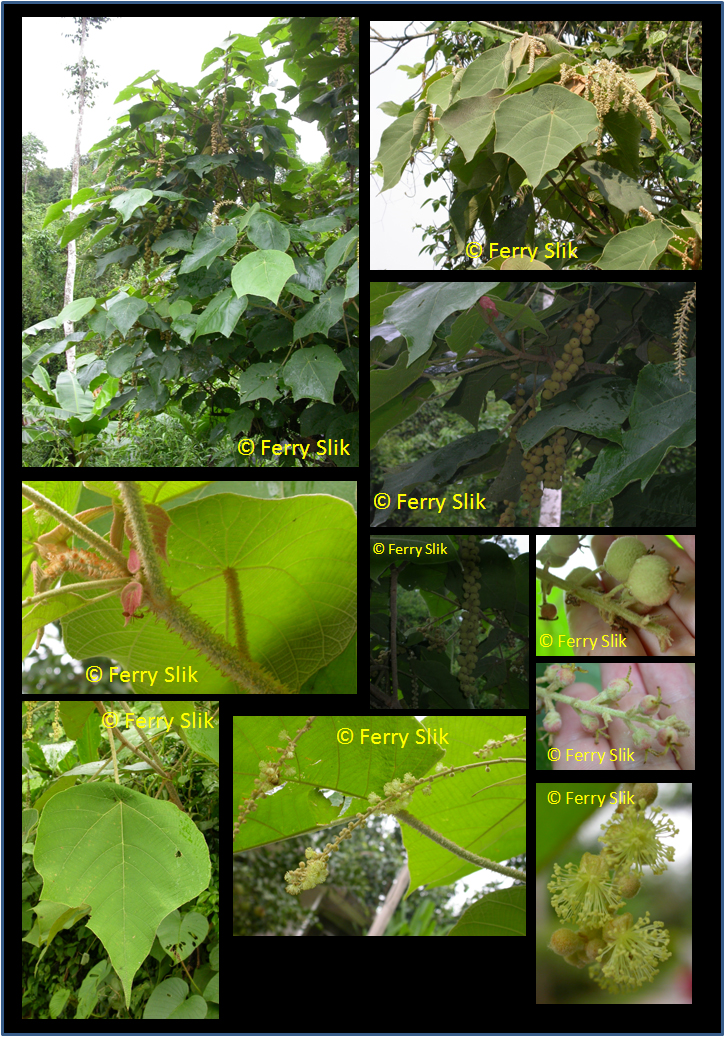Mallotus barbatus Müll.Arg., Linnaea 34: 184 (1865)
Name meaning 'bearded' or 'with long hairs' referring to the dense hairs all over the plant.Synonyms
Mallotus barbatus var. congestus F.P.Metcalf
Mallotus barbatus var. croizatianus (F.P.Metcalf) S.M.Hwang
Mallotus barbatus var. hubeiensis S.M.Hwang
Mallotus barbatus var. pedicellaris Croizat
Mallotus barbatus var. wui H.S.Kiu
Mallotus conspurcatus Croizat
Mallotus croizatianus F.P.Metcalf
Mallotus esquirolii H.Lév. [Illegitimate]
Mallotus leveillanus Fedde
Mallotus lotingensis F.P.Metcalf
Mallotus luchenensis F.P.Metcalf
Rottlera barbata Wall.
Rottlera barbata Wall. ex Baill. [Invalid]
Description
Shrubs to small trees up to 12 m high, dbh up to 15 cm, monoecious or dioecious. Indumentum densely hairy, very soft-floccose, flocci
up to 6 mm long. Stipules linear-triangular, 1017 by 0.81.2 mm. Leaves alternate to apically subopposite; petiole 340 by 27 mm,
blade peltate for 1080 mm, broadly ovate to ovate, 10.558 by 945 cm, length/width ratio 11.3, base truncate, rounded or obtuse,
margin dentate, sometimes 2-lobed at widest part of blade, longest lobes up to 50 mm, basally with 04 extrafloral nectaries, marginal
nectaries 09 per side, lower surface brownish green, palminerved. Inflorescences terminal, unisexual or bisexual. Staminate inflorescences
up to 65 cm long, side branches up to 30 cm long, with 2 or 3 flowers per node, nodes per branch up to 130. Staminate flowers 69 mm diam.;
pedicels 35.5 mm long; sepals 4 or 5, 35 by 1.33 mm, pale light cream to tan cream; stamens 6085, pale light green to yellow. Pistillate
inflorescences racemes, up to 55 cm long, occasionally with side branches, up to 10 cm long, nodes up to 80. Pistillate flowers 46 mm diam.;
pedicels 145 mm long; calyx (3-) or 4- or 5- or (6-)lobed, connate on the base, 2.55 mm long, lobes 23 by 1.52.5 mm; ovary 3(5)-locular;
style up to 1.5 mm long; stigmas 26 mm long, yellow. Fruit 1021 by 1420 mm, with strong smell, yellow with reddish touch, spines numerous,
straight, thin, less hairy, up to 7 mm long, hairs forming a continuous layer, rubbing off. Seeds ellipsoid, 4.85.5 by 34.5 by 24 mm,
surface smooth, black.
Ecology
Locally common in deciduous and evergreen forest, mostly in open, often very disturbed or burned places, along road and river sides;
on a large variety of soil types, like shale, limestone, sandstone, and sandy clay. Altitude: sea level up to 1400 m.
Distribution
From India (W Bengal) to South China, Southeast Asia mainland, Malay Peninsula, Sumatra, and Java.
Uses
The roots and fruits are used against muscle stiffness. The seeds yield a fatty oil used for making candles.
Local names
Peninsular Malaysia: Baleh anging, Ba-le-a-nging, Balek angin, Balik angin, Tampun.
